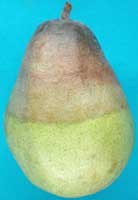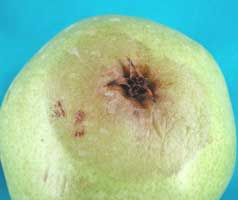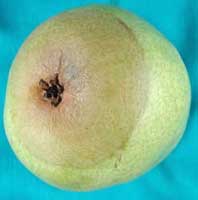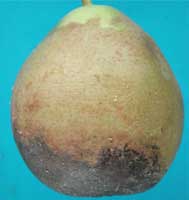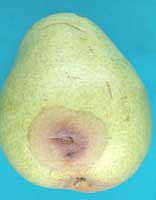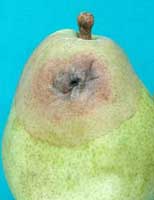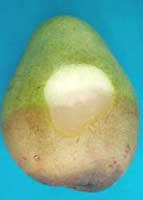ID Gallery: Phacidiopycnis Rot – Speck Rot
View the 360 Rotator
showing multiple images of the external disease symptoms.
Phacidiopycnis rots are emerging postharvest diseases of apple and pear in the U.S. Pacific Northwest. These diseases have previously been reported in Europe and India and most recently in Chile. In Washington State and Oregon, Phacidiopycnis rot is common on pears, whereas speck rot is more common on apples in Washington State. Recent surveys have confirmed that these rots continue to be an emerging threat in the PNW and will require future management attention.
For more information about Phacidiopycnis rot and Speck rot and their management visit our page Postharvest Diseases: Phacidipycnis Rot.
Speck Rot in Apple
This rot of apples is primarily caused by P. washingtonensis and is referred to as Speck rot. Speck rot presents with two symptoms. Flesh infections are spongy to firm, not separable from healthy tissue, and is sometimes visually similar to gray mold. The color of the decayed area is light to dark brown, and black in advanced stages. A second symptom of infection starts at lenticels. Symptoms are brown to black specks with a white to light tan center around the lenticels. Both symptoms appear more often on the calyx and stem end of the fruit.
Early speck rot infection developing on Granny Smith under high humidity. Photo: A. Amiri, WSU TFREC.
Internal view of a rare speck rot infection of Fuji in an orchard in the Pacific Northwest after heavy rain. Photo: A. Amiri, WSU TFREC.
Cross section of a speck rot lesion showing black coloration f the internal flesh of Granny Smith. Photo: A. Amiri, WSU TFREC.
Phacidiopycnis rot in Pear
This infection in pears is primarily caused by P. pyri and is referred to as Phacidiopycnis rot.
Early-stage stem-end Phacidiopycnis rot on a d’Anjou pear. Note the water-soaked appearance. Photo: CL Xiao, USDA-ARS.
The color of decayed area varies with age. Water-soaked at the margin. Black pycnidia at aged area near stem. Photo: A. Amiri, WSU TFREC.
Advanced stage of P. pyri infection showing black coloration of the decayed area. Photo: A. Amiri, WSU TFREC.
Early stage of stem-end Phacidiopycnis rot on a d’Anjou fruit; watersoaked appearance. Photo: CL Xiao, USDA-ARS.
Advanced stage of stem-end rot showing the change in color across the decayed area. Photo: CL Xiao, USDA-ARS.
Early stage of wound infection commonly associated with limb rubs or punctures on the fruit created at harvest. Photo: CL Xiao, USDA-ARS.
Phacidiopycnis rot from wound infection; the infection site turns brown to black as the decay advances. Photo: CL Xiao, USDA-ARS.








